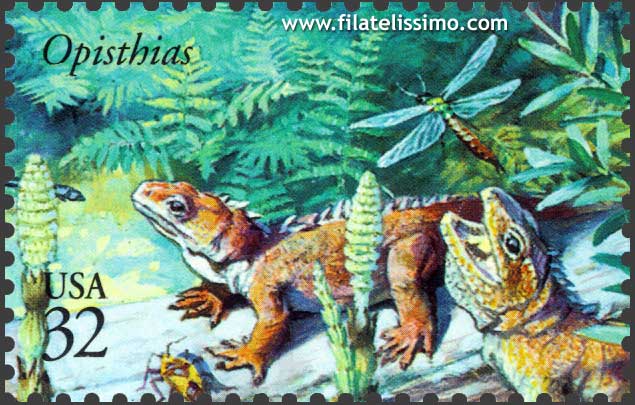 *ScienceDaily (Mar. 23, 2008) — "In a study of New Zealand's "living dinosaur" the tuatara, evolutionary biologist, and ancient DNA expert, Professor David Lambert and his team from the Allan Wilson Centre for Molecular Ecology and Evolution recovered DNA sequences from the bones of ancient tuatara, which are up to 8000 years old. They found that, although tuatara have remained largely physically unchanged over very long periods of evolution, they are evolving - at a DNA level - faster than any other animal yet examined."
*ScienceDaily (Mar. 23, 2008) — "In a study of New Zealand's "living dinosaur" the tuatara, evolutionary biologist, and ancient DNA expert, Professor David Lambert and his team from the Allan Wilson Centre for Molecular Ecology and Evolution recovered DNA sequences from the bones of ancient tuatara, which are up to 8000 years old. They found that, although tuatara have remained largely physically unchanged over very long periods of evolution, they are evolving - at a DNA level - faster than any other animal yet examined." "Of course we would have expected that the tuatara, which does everything slowly -- they grow slowly, reproduce slowly and have a very slow metabolism -- would have evolved slowly. In fact, at the DNA level, they evolve extremely quickly, which supports a hypothesis proposed by the evolutionary biologist Allan Wilson, who suggested that the rate of molecular evolution was uncoupled from the rate of morphological evolution."
"Of course we would have expected that the tuatara, which does everything slowly -- they grow slowly, reproduce slowly and have a very slow metabolism -- would have evolved slowly. In fact, at the DNA level, they evolve extremely quickly, which supports a hypothesis proposed by the evolutionary biologist Allan Wilson, who suggested that the rate of molecular evolution was uncoupled from the rate of morphological evolution.""The tuatara, Sphendon punctatus, is found only in New Zealand and is the only surviving member of a distinct reptilian order Sphehodontia that lived alongside early dinosaurs and separated from other reptiles 200 million years ago in the Upper Triassic period." (Continue reading....)
I am currently reading Jurassic West and remembered that John mentions Tuatara's (and of course, other sphenodontians, page 142-144). The first Morrison Formation sphenodontian was found at Como Bluff by the crew of O.C. Marsh, but was not recognized for some time. This is Opisthias, which was described by Gilmore in 1910. This is sphenodontian is the most common species in
 the Morrison Formation and is also known from the Purbeck Formation in England. Theretairus (Simpson 1926) is known from two specimens (the holotype is a single dentary from Como Bluff), although some consider it to be a juvenile form of Opisthias. The larger and more robust Eilenodon was discovered in the Morrison beds of the Fruita Paleo Area, Colorado (Rasmussen and Callison, 1981), and is known known from four new localities in Utah and Colorado. Eilenodon is a member of a group of larger sphenodontians, related to the Early Cretaceous Toxolophosaurus (Montana) and Late Cretaceous Priosphenodon (Argentina).
the Morrison Formation and is also known from the Purbeck Formation in England. Theretairus (Simpson 1926) is known from two specimens (the holotype is a single dentary from Como Bluff), although some consider it to be a juvenile form of Opisthias. The larger and more robust Eilenodon was discovered in the Morrison beds of the Fruita Paleo Area, Colorado (Rasmussen and Callison, 1981), and is known known from four new localities in Utah and Colorado. Eilenodon is a member of a group of larger sphenodontians, related to the Early Cretaceous Toxolophosaurus (Montana) and Late Cretaceous Priosphenodon (Argentina).References: Foster, J.R. 2007. Jurassic West: The dinosaurs of the Morrison Formation and their world. Indiana University Press. 389 pp.
Gilmore, C.W. 1910. A new rhynchocephalian reptile from the Jurassic of Wyoming, with notes on the fauna of "Quarry 9." Proceedings of the United States National Museum 37: 35-42.
Hay, J.M., Subramanian, S., Millar, C.D., Mohandesan, E. and Lambert, D.M. 2008. Rapid molecular evolution in a living fossil. Trends in Genetics 24: 106-109. (http://dx.doi.org/10.1016/j.tig.2007.12.002)
Rasmussen, T.E. and Callison, G. 1981. A new herbivorous sphenodontid (Rhynchocephalia: Reptilia) from the Jurassic of Colorado. Journal of Paleontology 55: 628-634.
Simpson, G.G. 1926. American terrestrial Rhynchocephalia. American Journal of Science 5: 12-16.
*(2008, March 23). New Zealand's 'Living Dinosaur' -- The Tuatara -- Is Surprisingly The Fastest Evolving Animal. ScienceDaily. Retrieved March 23, 2008
images from: iStockphoto/Robyn Grant, http://www.geocities.com/RainForest/6525/tuatara.html & http://www.filatelissimo.com/wp-content/uploads/2007/09/dinosaurios_opisthias.jpg
No comments:
Post a Comment